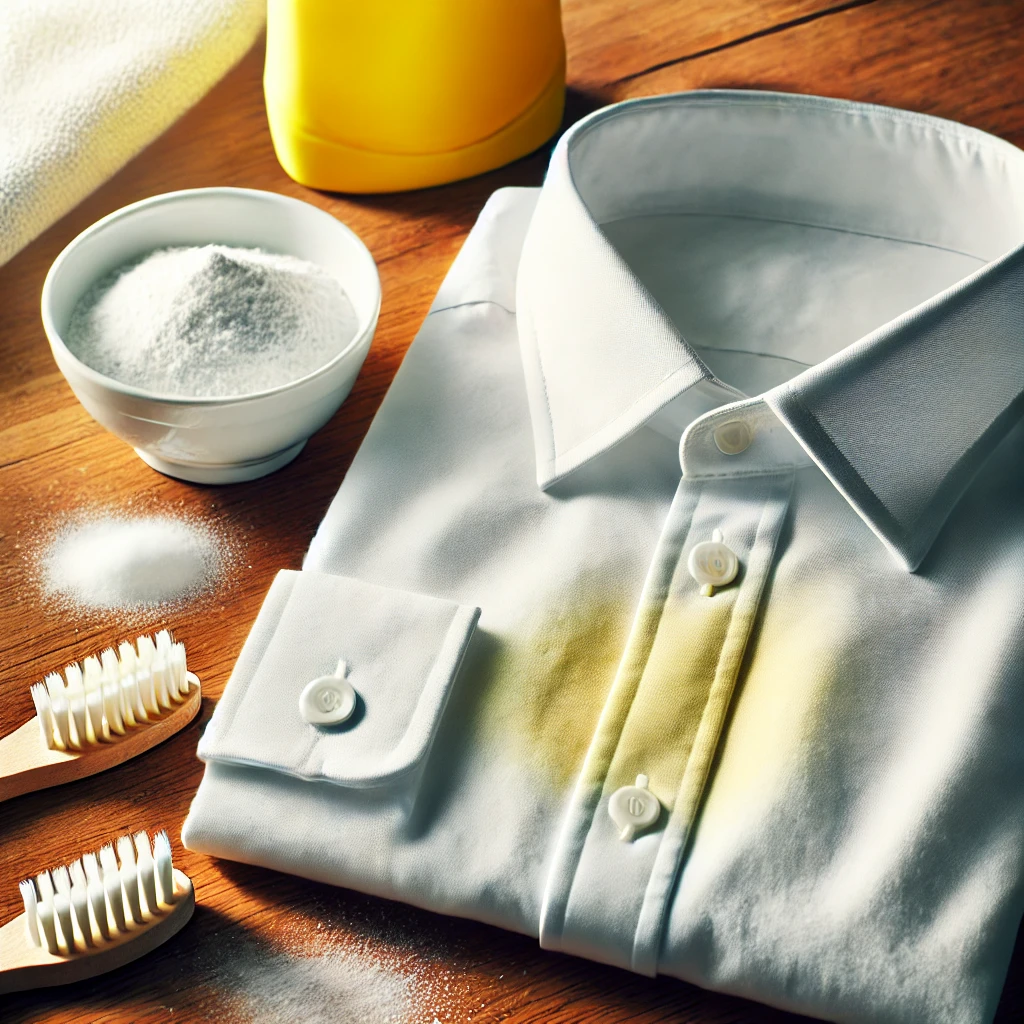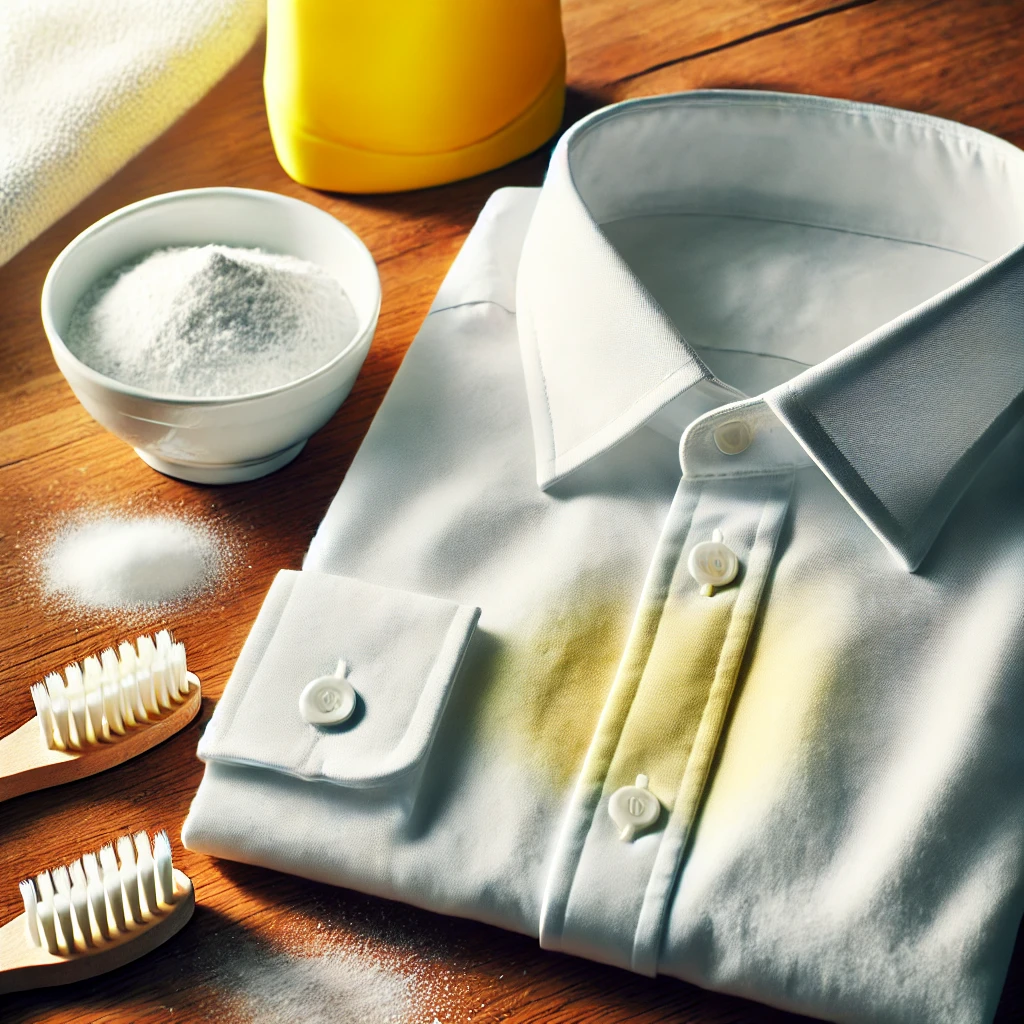
1. Why Do Shirt Collars Turn Yellow? Understanding the Causes
Sebum and Sweat Accumulate and Oxidize
Sweat and body oils naturally secrete from the skin, especially around the neck. These oils gradually soak into the fabric, and when exposed to air over time, they oxidize, leading to yellow stains. The more frequently a shirt is worn without proper washing, the more visible these stains become.
Residual Detergent and Dirt Accumulate Over Time
Even if you wash your shirt regularly, improper washing techniques can leave behind detergent residues or minor dirt particles. These substances build up with each wash cycle, creating a dull, yellowish tinge that becomes difficult to remove.
Laundry and Storage Conditions Affect Discoloration
Washing shirts in cold water or failing to rinse them thoroughly can contribute to staining. Additionally, storing shirts in humid conditions accelerates oxidation, making yellow stains appear even faster. Proper washing and storage techniques play a crucial role in keeping collars white.
2. Preventative Measures to Avoid Collar Stains
Apply Baby Powder or Spray Before Wearing
A simple trick to prevent sebum absorption is to lightly dust the collar with baby powder before wearing the shirt. This forms a protective barrier that reduces direct contact with sweat and oils. Alternatively, anti-stain sprays can be used for extra protection.
Wear an Undershirt to Minimize Direct Sweat Contact
A well-fitted undershirt acts as a sweat absorber, preventing moisture from reaching the shirt’s collar. Choosing moisture-wicking undershirts can further enhance protection and keep the shirt looking fresh throughout the day.
Wash Regularly to Prevent Dirt Accumulation
Frequent washing is the best way to prevent stains from setting. Leaving shirts unwashed for several wears allows oils and sweat to settle deeply into the fabric, making them harder to clean later. Washing after each wear significantly reduces yellowing.
3. Washing Methods to Remove Yellowing from Collars
Soaking in Warm Water and Detergent for Better Results
Soaking shirts in warm (not hot) water with a powerful detergent before washing helps loosen trapped dirt and oils. A 30-minute soak significantly improves cleaning efficiency and reduces yellowing.
Using Baking Soda and Vinegar for Natural Cleaning
For a chemical-free alternative, mix baking soda and vinegar into a paste and apply it directly to the yellowed areas. Let it sit for about 15 minutes before scrubbing gently. This method is especially useful for delicate fabrics.
Scrubbing with a Laundry Brush for Deep Cleaning
Using a soft-bristle laundry brush on stubborn stains before washing helps break down deep-seated oils and dirt. Brushing should be done gently to avoid damaging the fabric.
4. Choosing the Right Detergents & Bleaching Agents
Features and Selection of Collar-Specific Stain Removers
Many detergents are formulated specifically to target collar stains. Look for enzymatic or oxygen-based stain removers, as they effectively break down oils without damaging the fabric.
Differences Between Oxygen Bleach and Chlorine Bleach
Oxygen bleach is a safer alternative for white shirts, as it removes stains without weakening fibers. Chlorine bleach, while effective, can be too harsh and may degrade fabric quality over time.
Recommended Natural Detergents for Sensitive Skin
For those with sensitive skin, plant-based or hypoallergenic detergents are ideal. These products contain fewer harsh chemicals while still effectively lifting stains from shirt collars.
5. Maintenance Tips to Keep Shirts White Longer
Establish a Habit of Washing Immediately After Use
Washing shirts as soon as they are worn prevents sweat and oils from settling. This simple habit extends the shirt’s lifespan and keeps it looking pristine.
Ensure Proper Drying Before Storing to Prevent Yellowing
Damp conditions promote oxidation and mold growth, both of which contribute to yellow stains. Dry shirts thoroughly before placing them in storage to maintain their whiteness.
Proper Storage Methods to Extend Shirt Longevity
Store shirts in a cool, dry place using breathable garment bags or silica gel packs to absorb excess moisture. This method prevents yellowing and keeps shirts fresh for longer.
Conclusion
Keeping your shirt collars free from yellow stains is a combination of proper washing techniques, preventative measures, and storage habits. By incorporating these simple methods into your routine, you can maintain crisp, white collars for a long time.



Comment